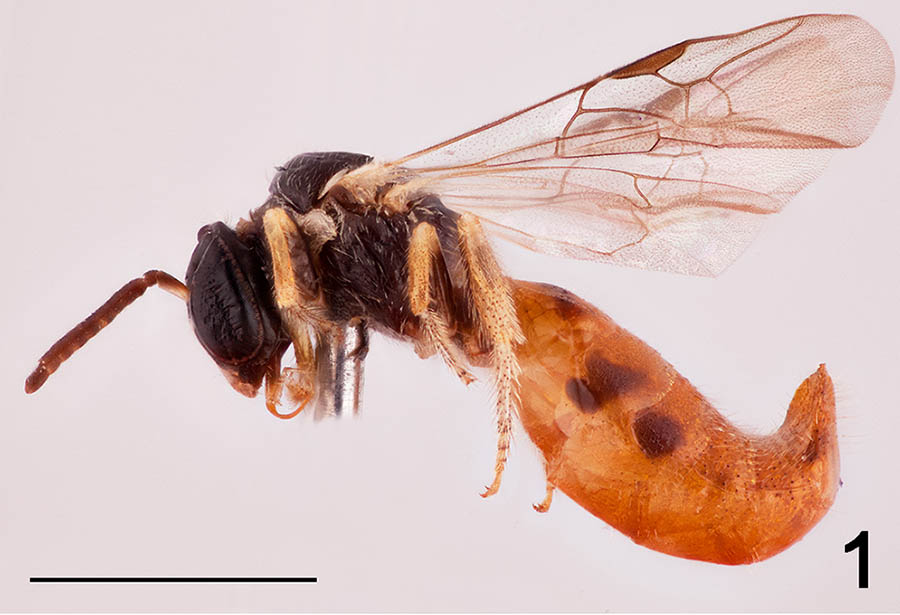A new socially parasitic Braunsapis (Hymenoptera: Apidae: Xylocopinae: Allodapini) from Vietnam, with a key to female socially parasitic Braunsapis in Asia
DOI:
https://doi.org/10.17161/jom.v0i79.6742Keywords:
Apidae, Allodapini, adaptations to social parasitismAbstract
Braunsapis scorpius Packer, new species, from Vietnam, is diagnosed, described, and illustrated. In addition to adaptations commonly associated with related social parasites (i.e., reduced metatibial hairs, short mouthparts, and absence of a basitibial plate), it has a remarkably recurved metasomal apex. It is compared to other socially parasitic members of its genus from Asia and a key to females of these social parasites is provided.References
Batra, S.W.T., S.F. Sakagami & Y. Maeta. 1993. Behavior of the Indian allodapine bee Braunsapis kaliago a social parasite in the nests of B. mixta. Journal of the Kansas Entomological Society 66(3):345 ? 360.
Brothers, D.J. 1976. Modification of the metapostnotum and origin of the “propodeal triangle” in Hymenoptera Aculeata. Systematic Entomology 1(3):177 ? 182.
Harris, R.A. 1979. A glossary of surface sculpturing. Occasional Papers in Entomology 28:1 ? 31.
Michener, C.D. 2007. The Bees of the World [2nd Edition]. Johns Hopkins University Press; Baltimore, MD; xvi+[i]+953pp., +20 pls.
Michener, C.D., R.M. Borges, M. Zacharias & M. Shenov. 2003. A new parasitic bee of the genus Braunsapis from India (Hymenoptera: Apidae: Allodapini). Journal of the Kansas Entomological Society 76(3): 518 ? 522.
Packer, L. & S. Dumesh. 2014. Two new species of Geodiscelis (Hymenoptera: Apoidea: Colletidae) with a phylogenetic analysis and subgeneric classification of the genus. Zootaxa 3857: 275 ? 291.
Reyes, S.G. 1991. A revision of the bee genus Braunsapis in the oriental region. University of Kansas Science Bulletin 54(6): 179 ? 207.
Reyes, S.G. & C.D. Michener. 1990. Observations on a parasitic allodapine bee and its hosts in Java and Malaysia (Hymenoptera Anthophoridae Allodapine [sic]). Tropical Zoology 3(2):139 ? 149.
Reyes, S.G. & S.F. Sakagami. 1990. A new socially parasitic Braunsapis from India with notes on the synonymy of Braunsapis mixta (Hymenoptera: Xylocopinae: Alllodapini). Journal of the Kansas Entomological Society 63(3):458 ? 461.
Smith, J.A., S.M. Tierney, Y.C. Park, S. Fuller & M.P. Schwarz. 2007. Origins of social parasitism: the importance of divergence ages in phylogenetic studies. Molecular Phylogenetics and Evolution 43(3): 1131 ? 1137.
Smith, J.A., L.B. Chenoweth, S.M. Tierney & M.P.Schwarz. 2013. Repeated origins of social parasitism in allodapine bees indicate that the weak form of Emery’s rule is widespread, yet sympatric speciation remains highly problematic. Biological Journal of the Linnean Society 109(2): 320 ? 331.
Downloads
Additional Files
Published
Issue
Section
License
Copyright for articles published in Journal of Melittology is retained by the authors, with first publication rights granted to the journal. By virtue of their appearance in this open access journal, articles are free to use, with proper attribution and permission of the authors, in educational and other non-commercial settings.





